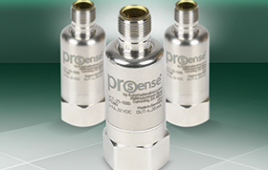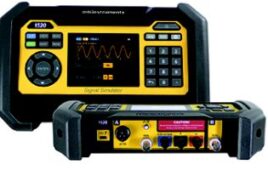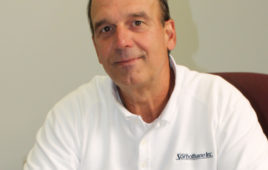We spoke to two major manufacturers about how they are dealing with these changes and how their technologies continue to meet the needs of industrial automation. Read on as Christopher Kudla, senior applications engineer with ITT Enidine, and Scott McNeil, global engineering director from ACE Controls, share their insights on the market’s impact on their technologies.
Q. What industries are spurring changes in today’s shock absorbers/vibration dampening components? Which of these are using more of your components than ever?
Scott McNeil, Global Engineering Director, ACE Controls: Our shock absorbers are used in a wide range of industries as a cost-effective way to protect machines and save money in the long run. For instance, as food and beverage machines move faster and produce at higher volumes, machine builders use our shock absorbers to prevent machine damage and reduce downtime and maintenance. One example is our PET shock absorber, which is used in the polyethylene plastic bottle industry and is duty rated 20+ million cycles, or roughly one year, more than twice as long as previous designs.

ACE Controls’ latest innovation is the PET 27M 20-million cycle shock absorber, designed for the food and beverage industry.
In the aerospace industry, we have shock absorbers and gas springs in a variety of airplanes and helicopters as well as simulators, launch towers, aircraft test equipment and so forth. We’re also constantly figuring out new ways for our shocks to work in extreme environments such as undersea and saltwater. Our products are being used in oil drilling applications for improved safety and environmental protection.
Christopher Kudla, Senior Applications Engineer, ITT Enidine: The most notable changes we are seeing revolve around the speed of manufacturing in the food and beverage industry. There is an increasing demand to run the machines faster, which typically results in more frequent maintenance. The challenge for shock absorber manufacturers is to continuously improve their designs to have the longest lasting product on the market. End users demand faster operating speeds, and through continuous improvement of the shock absorber designs, the market is becoming increasingly competitive.
Q. What about the changes your technologies have spurred over the last decade and where design engineers should consider specialty designs?
Christopher Kudla, Senior Applications Engineer, ITT Enidine: Many of the big changes in energy absorption devices over the last decade are driven by the use of these products in harsh environments. For example, the demand to use a shock absorber in extreme temperatures, highly caustic washdown areas, or high cycle-rate applications has led to an evolution of components. Some of these changes include custom improvements on seal designs and also construction materials like high-strength, aircraft-grade aluminum.
Scott McNeil, Global Engineering Director, ACE Controls: The changes we’re looking at lately are largely material-driven, with a shift from steel, iron, brass, rubber and petroleum oils to various stainless steels, aluminum, polymers, synthetic oils and silicones. There’s a big effort being placed on improving seals with new materials for durability of life, which we see for example in the PET shocks.
3D manufacturing techniques are another form of technology we continue to keep a close eye on. We’ve felt that 3D manufacturing isn’t yet mature enough for mass production. We have an active 3D project where we’re making parts with different materials and suppliers. By carefully monitoring the industry, we are prepared to jump in when we feel it’s ready.
Q. What are some technological advances improving the performance of shock absorbers and vibration-damping components?
Christopher Kudla, Senior Applications Engineer, ITT Enidine: The technological advances providing the most benefit to the industry are those that extend the life of our custom high cycle-rate shock absorbers. For industries that operate their equipment on the order of millions of cycles per month, the life of the shock absorber directly contributes to the equipment uptime and production efficiency. At Enidine we are always performing cycle life testing, allowing us to implement continuous improvements on our new designs.
Scott McNeil, Global Engineering Director, ACE Controls: We’re at a point where our shocks have become efficient in so many ways. But our team is constantly looking for new ways to increase life by improving seals, finishes and bearing designs, as well as generally looking for lighter, stronger and more efficient materials. In some of our recent shock absorbers and vibration dampening components, we were able to increase previous life by a factor of 4 or 5, just by addressing these concerns. We’re also using materials that are safer for the environment to make the shocks more ecologically friendly. We continue to look at improving the basic hydraulics and believe there are improvements yet to come in these highly developed areas.

ITT Enidine’s LROEM ¾ x 1 with a square flange and stop collar accessory mounted to it. These adjustable hydraulic shock absorbers offer the most flexible solutions to energy absorption application requirements when input parameters vary or are not clearly defined.
Tell us about an application where engineers used your shock absorbers or vibration-damping components.
Scott McNeil, Global Engineering Director, ACE Controls: PAD material is commonly used under electrical transformers and large machines to isolate noise and vibration from buildings and factories. This quick and easy solution has become increasingly common. In the past, engineers and building dwellers would just accept the vibration and noise. Today’s machines are being more densely packed into buildings and in some cases buildings are not designed as strong and robust as in the past.
Our air mount product lines, such as Pneumatic Leveling Mounts (PLM) and Pneumatic Isolators with Automatic Level Control (PAL), can isolate vibrations in high-tech applications. They can protect high precision equipment and operations such as optic measuring or grinding from being disturbed by vibrations from subways, trains or vehicles. They can also prevent vibrations from equipment from transmitting to the rest of the building, in the case, for example, on vehicle or engine dynamometers. As factories are being built closer to residential and densely packed areas, there’s an increased need to isolate vibration. These PLMs and PALs are now being included in machine designs to make sure vibration doesn’t cause any issues.
Christopher Kudla, Senior Applications Engineer, ITT Enidine: A modern example showcasing the benefits of vibration isolating products is the growing use of cameras and sensors on autonomous vehicles. Used for conducting aerial surveys, positioning agricultural vehicles, military reconnaissance or cinematic production, these applications would not be possible without the use of vibration isolation mounts tuned specifically for each system. These mounts are typically wire rope isolators and they prevent the disruption of the camera or sensor from vibration of the propeller blades, rough ground terrain and even harsh impact landings.
ACE Controls
www.acecontrols.com
ITT Enidine
www.enidine.com
You may also like:
Filed Under: Mobile Hydraulic Tips, Shocks + vibration control • gas springs







